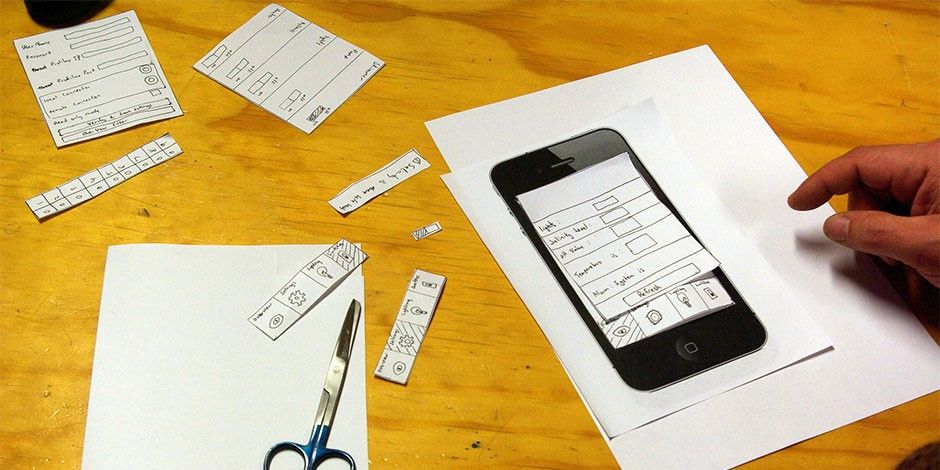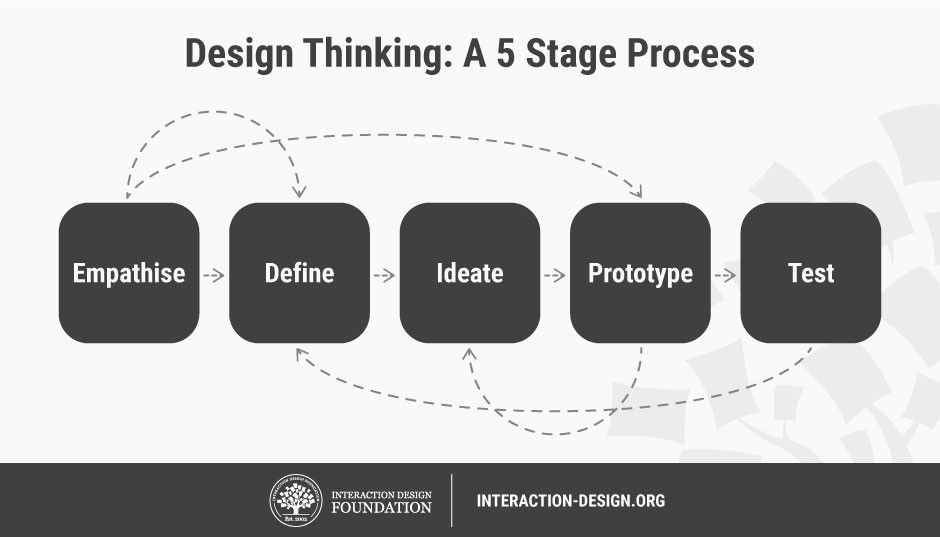Were Having a Little Trouble Loading Your Prototype. Can You Try Again Later
Prototyping is an integral part of Design Thinking and User Experience design in general because it allows us to test our ideas quickly and better on them in an every bit timely way. The Establish of Design at Stanford (d.school) encourages a "bias towards action", where building and testing is valued over thinking and meeting. Yet, why is prototyping so of import in the design procedure? Moreover, how does it help you create homo-centred design solutions? Before nosotros start making prototypes to examination our assumptions, let'due south go a closer understanding backside the what, how and why of prototyping.
Imagine this situation: Information technology's an heady new project, something your squad had spent months brainstorming and planning, and so building and crafting to perfection. You lot did all y'all could to ensure it was just correct, with all the necessary features. You tried to ensure that you gave blueprint more focus and that your message was crafted well. The website attracted attention and brought in many interested visitors looking for the products y'all'd nerveless on the site, merely somehow the production and service providers merely weren't interested in testing it out. They seemed comfortable but to continue doing business organization as usual, uninterested in the thousands of hits your website was getting from potential customers. It made no sense to you lot, but at that place you were months later, having sweated and spent valuable fourth dimension, coin, and resource and even attracting visitors, but no customers.
What went wrong?
It's a story repeated time and time again—ideas existence executed past people with an obsession for making a paring in the market, making large changes in social club or just completely re-inventing the wheel, only to realise right at the end of their journey that they've been wasting their time or focussing on the wrong thing.
This is where prototyping comes in past providing a set of tools and approaches for properly testing and exploring ideas before too many resources become used. Many of the states may recall the fine art of prototyping from our early childhood where nosotros created mock-ups of existent-world objects with the simplest of materials such as paper, card, and modelling dirt or merely about anything else we could get our hands on. There is not much difference between these types of prototypes and the early rough prototypes we may develop at the before phases of testing out ideas.
"If a picture is worth a thousand words, then a epitome is worth a 1000 meetings."
– Proverb at IDEO
What is a Prototype?
 Author/Copyright holder: Samuel Mann. Copyright terms and licence: CC BY 2.0
Author/Copyright holder: Samuel Mann. Copyright terms and licence: CC BY 2.0
Whatever finished product is just that—at the finishing line of a journey, a design journey involving a epitome or two (or more than) with working titles such as 'Mark I', 'Mark II', 'Mark Three', and and so on.
A prototype is a unproblematic experimental model of a proposed solution used to exam or validate ideas, pattern assumptions and other aspects of its conceptualisation apace and cheaply, and then that the designer/south involved tin can brand appropriate refinements or possible changes in direction.
Prototypes can take many forms, and just about the only matter in common the various forms have is that they are all tangible forms of your ideas. They don't have to be primitive versions of an terminate product, either—far from it. Simple sketches or storyboards used to illustrate a proposed experiential solution, crude paper prototypes of digital interfaces, and even role-playing to act out a service offering an idea are examples of prototypes. In fact, prototypes do non need to be full products: y'all can image a part of a solution (like a proposed grip handle of a wheelchair) to test that specific role of your solution.
Prototypes can be quick and crude — useful for early on-stage testing and learning — and can also exist fully formed and detailed — unremarkably for testing or airplane pilot trials near the cease of the project.
Prototyping is virtually bringing conceptual or theoretical ideas to life and exploring their real-globe impact before finally executing them. All too often, pattern teams get in at ideas without enough enquiry or validation and expedite them to final execution before there is whatever certainty almost their viability or possible effect on the target group.
Why We Need to Epitome
Early Research isn't Everything
Research conducted during the early stages of your Design Thinking project does not tell yous everything you lot need to know in society to create the optimal solution. Regardless of whether you have researched thoroughly and gathered a big body of information, or whether your ideation sessions have resulted in what many perceive equally a earth-changing solution, testing is however crucial for success. Design teams tin can easily become fixated on the inquiry artefacts they accept gathered during the earlier phases of exploration, creating a bias towards their ideas. Past prototyping and then testing those prototypes, you tin can reveal assumptions and biases you have towards your ideas, and uncover insights about your users that you tin use to improve your solutions or create new ones.
Yous can apply prototyping as a form of research fifty-fifty earlier other phases in Pattern Thinking, allowing you to explore problem areas in interfaces, products or services, and spot areas for improvement or innovation.
 Author/Copyright holder: Teo Yu Siang and Interaction Design Foundation. Copyright terms and licence: CC By-NC-SA iii.0
Author/Copyright holder: Teo Yu Siang and Interaction Design Foundation. Copyright terms and licence: CC By-NC-SA iii.0
Design Thinking is a design methodology that provides a solution-based approach to solving problems. It'south extremely useful in tackling complex bug that are sick-defined or unknown, by understanding the human needs involved, by reframing the problem in homo-centric ways, by creating many ideas in brainstorming sessions, and by adopting a hands-on approach in prototyping and testing. The five stages of Pattern Thinking are not sequential steps, but unlike "modes" you tin can put yourself in, to iterate on your problem statement, ideas, or epitome, or to acquire more near your users at any point during the project.
Prototype to Empathise, Define, Ideate, and Exam
We can — and should — use prototyping as function of diverse stages of Design Thinking. You tin can employ prototyping equally an ideation method, every bit it allows yous, as well equally users, to explore alternative solutions. This is possible because prototypes are concrete representations of your solutions, and thus prototyping allows yous to think past doing. Adopting a 'thinking by doing' mindset is extremely helpful in letting you derive more value from researching, defining, ideating, and testing.
Some of the purposes that prototypes fulfil are:
Exploring and Experimentation
You can use prototypes to explore issues, ideas, and opportunities inside a specific area of focus and exam out the touch of incremental or radical changes.
Learning and Understanding
Use prototypes in order to improve understand the dynamics of a problem, product, or organization by physically engaging with them and picking autonomously what makes them work or neglect.
Engaging, Testing, and Experiencing
Apply prototyping to engage with end users or stakeholders, in ways that reveal deeper insight and more valuable experiences, to inform design decisions going forward.
Inspiring and Motivating
Use prototypes to sell new ideas, motivate buy-in from internal or external stakeholders, or inspire markets toward radical new ways of thinking and doing.
How Prototyping Works
Bias Towards Activeness
I of the essential mindsets for Design Thinking listed in d.school's Design Thinking Bootcamp Bootleg Toolkit is having a bias towards action:
"Design thinking is a misnomer; information technology is more nearly doing than thinking. Bias toward doing and making over-thinking and meeting."
– d.school
This means that analysis paralysis is unable to take hold, because y'all will investigate each supposition through active testing, instead of theoretically thinking it through. Past using controlled experiments, you lot can either prove or disprove your assumptions in their real context and thus farther refine — or even abandon — your initial idea.
Learning by Doing
1 of the nigh important aspects of Design Thinking is exploring unknown possibilities and uncovering unknown insights. This is the reason the discipline places emphasis on learning and on activities that increase the learning potential of the team. You can boost activeness-orientated learning by experimenting and exploring the proposed solutions in order to understand what problems may exist with the assumptions behind those solutions. Every bit such, your team can iterate rapidly, modifying your examination models and moving you lot closer and closer to the goal.
Creative Serendipity
Do breakthrough ideas really only come up from nowhere?—A spark of genius in a blitz of creativity? With the style breakthrough inventions, start-ups, and other revolutionary ideas are "sold" to inspire and encourage creativity, one would think that all we need is flipping a switch to a success mindset.
David and Tom Kelley, founders of international pattern house IDEO, discuss in their volume Creative Confidence the importance of cultivating artistic serendipity. They encourage the adoption of approaches that lead to an epiphany-friendly environment within oneself. The idea is this: past deeply immersing yourself within your bailiwick of interest, you can open up up opportunities for happy accidents. What this ways is that the vast majority of people who "stumble" across breakthroughs do so along their journey of engaging with the subject area area.
The Kelleys cite various examples of people who made breakthroughs non by thinking through solutions but past trying things and figuring them out. One of the all-time ways to acquire nigh the positive and negative dynamics of your solutions is to have concrete action, by experimenting with and exploring potential solutions. When y'all epitome, yous bring your ideas onto a tangible airplane, which will enable you lot and your team to see and hash out the pros and cons, to larn from users' feedback, and to create trivial opportunities for artistic serendipity. And then, stop thinking, and starting time doing at present.
The Accept Away
Many times, we tend to invest in exciting new ideas, brainstorming, and planning for their implementation — until we realise, later launching them, that our brilliant designs had no traction with our users. In other words, the assumptions we based our solutions on might have been wrong – and when they are wrong, they can lead to significant wastes of time and resources. Prototyping helps prevent this. Prototyping quickly, and frequently, is the best way to test your assumptions, acquire about users, and improve on your ideas. Prototypes can be anything from sketches on a napkin to role-playing: just annihilation that lets you lot make your ideas tangible and testable. Prototyping helps create a bias towards action (i.east., make rather than think) and opportunities for creative serendipity — the innovative spark you demand to create truly useful and revolutionary solutions.
References & Where to Acquire More
d.school Bootcamp Bootleg, 2013: http://dschool.stanford.edu/wp-content/uploads/2013/x/METHODCARDS-v3-slim.pdf
Tom Kelley and Dave Kelley, Creative Conviction: Unleashing the Creative Potential Within U.s. All, 2013.
Hero Prototype: Author/Copyright holder: m0851. Copyright terms and licence: CC0
Source: https://www.interaction-design.org/literature/article/design-thinking-get-started-with-prototyping
0 Response to "Were Having a Little Trouble Loading Your Prototype. Can You Try Again Later"
Post a Comment